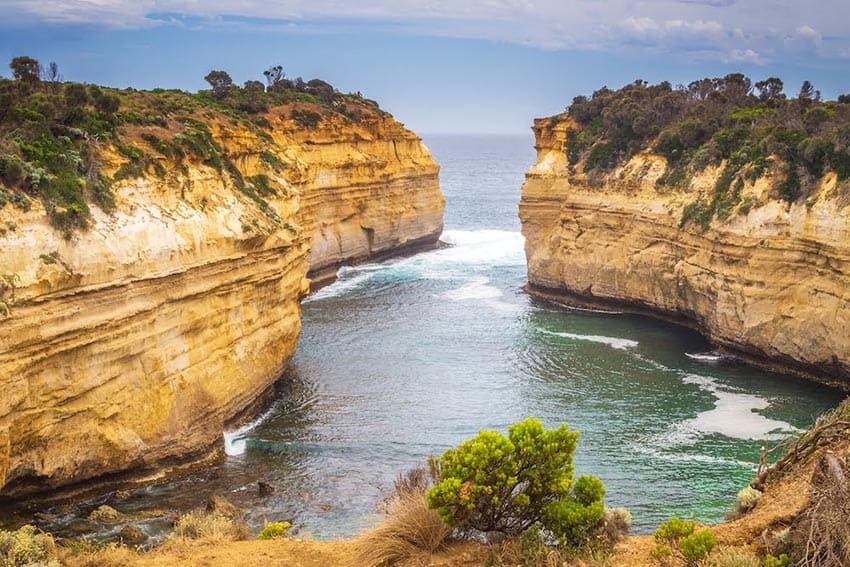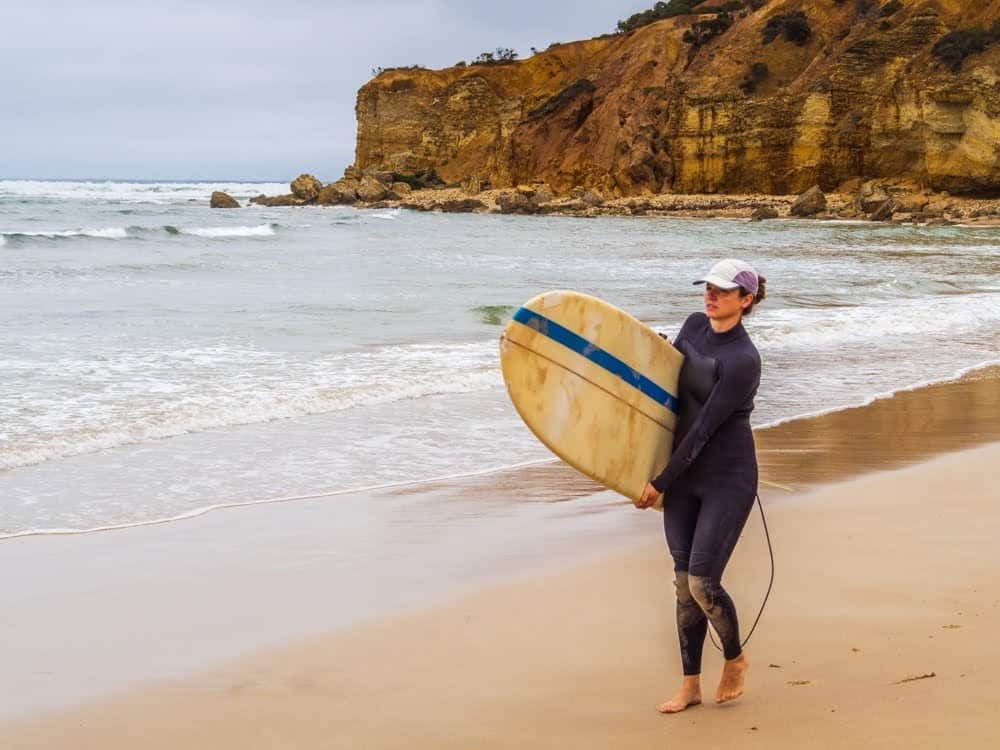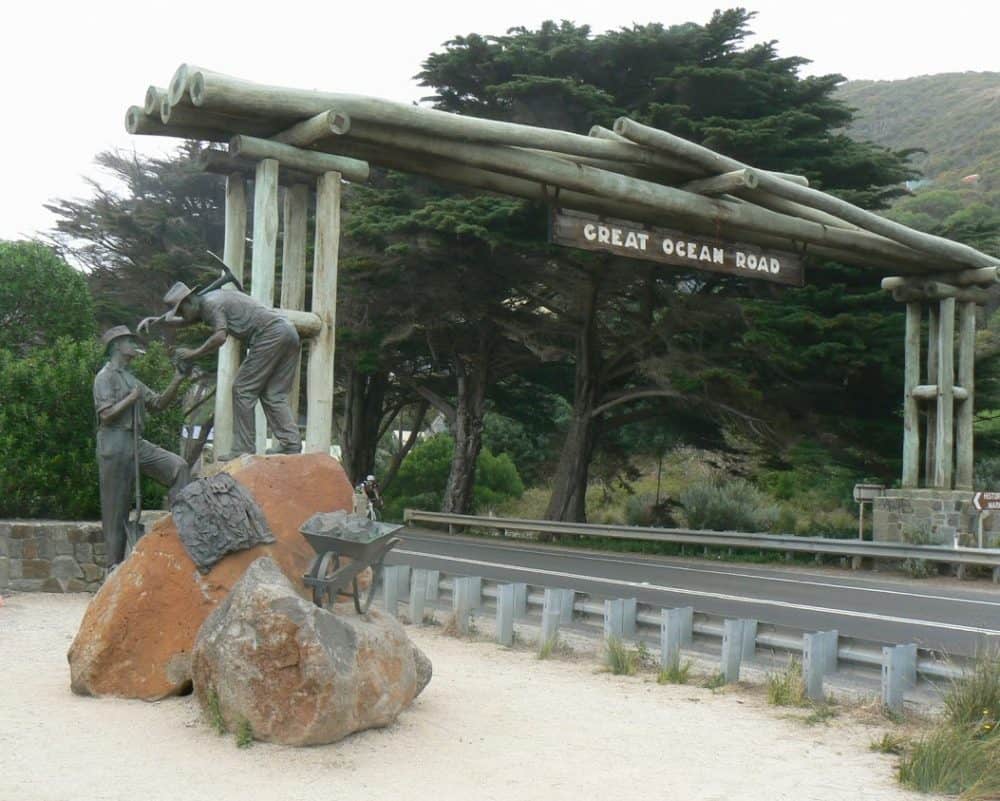
Victoria’s Spectacular Great Ocean Road!
By Helen Downs
When soldiers returned from World War I and started to build the Great Ocean Road a century ago, I wonder

if they had any idea how popular a tourist destination it would become?
Now sought after and explored by many, the Great Ocean Road provides easy access to the beautiful and varied south-west Victoria, Australia coast.
Don’t be surprised if you are tempted to stop, walk to the lookouts and absorb the breathtaking views it offers as you drive along.
The incredible contrast you see when surrounded by the rich green hills and pastoral scenes in the magnificent Otway National Park is quite overwhelming.
Driving along the Great Ocean Road is the best way to explore the south-west Victorian coastline which is divided into three regional areas.

These are the Surf Coast, the Shipwreck Coast and the Otways.
The Surf Coast
If you have a passion for surfing, you can head on down to the surfing capital of Torquay where advanced riders can catch some of the best waves.
Bells Beach has two main breaks, the Bowl and Rincon and challenging breaks can also be found at nearby Winki Pop, Centreside, and Southside.
Popular surfing spots can also be found between Aireys Inlet and Lorne and these include Cathedral Rock and Vera Lynn at Lorne Point. Between Lorne and Apollo Bay, there are more good surf spots at the Cumberland, Wye and Kennett Rivers, Baldy Rock, Skenes Creek and Sawmills.
Johanna Beach, 35 kilometers west of Apollo Bay is recognized as one of the top surfing beaches in Victoria. Here you will find big beach breaks on the steeply sloping ocean floor with an assortment of reefs and beach breaks around Castle Cove. Similar surfing conditions will be found at Princetown, Gibson Steps, Port Campbell and Peterborough.
Further west you’ll come to Warrnambool where some great breaks can be found at Logan’s Beach, The Flume

and Levy’s Beach. If you’re looking for gentle surf head on down to East Beach at Point Fairy.
There are several excellent learn-to-surf schools along the coast. If you speak to the staff at the Information Centres, they will advise you of the best spots new surfers can try. There are some ideal waves for beginners to ride at Torquay, Anglesea, Fairhaven and Lorne.
The Shipwreck Coast
This fascinating stretch of water sweeps west from Moonlight Head to the pretty fishing village of Point Fairy. It includes Princetown, the Twelve Apostles, Port Campbell, Peterborough and the large western city of Warrnambool. There are up to 800 known vessels lying along the coastline.
Let’s focus on three of them so you will get a good idea of what happened more than a century ago and what you will see now.
Loch Ard Gorge is located at Port Campbell National Park and only 3.5 kilometers away from the renowned 12 Apostles and one of my favorite sites. These craggy outcroppings right offshore will stun you…talk about Instagrammable!
On 1 June 1878 The Loch Ard, a three-masted clipper ran aground on Muttonbird Island after her three-month journey from England. Only two of the 54 passengers survived Tom Pearce a ship’s apprentice, and Eva Carmichael, who was emigrating with her family. Both of them were 19 years old.

After being washed ashore Tom heard Eva’s cries for help and swam back to rescue her from drowning. He then climbed up the sheer cliff face to raise the alarm.
Eva lived in Australia for three months but was so grief-stricken by the loss of her family that she went back to Ireland. Tom was awarded the first gold medal of the Royal Humane Society of Victoria for his bravery and died at sea aged 49.
In June 2009 the arch of Island Archway collapsed and became two separate pillars. They have since been named Tom and Eva after the Loch Ard ‘s only two survivors.

Stairs down to the Beach
When you visit Loch Ard Gorge well-designed stairs lead you to the beach.
There is also a pathway that takes you to the eastern side of the gorge. You will also find numerous plaques, a small historical museum, and a cemetery that houses many of those who died. There is also a lovely leisure area where you can simply sit down and relax.
Several scenes from films and TV series have been photographed here and these include the 1999 TV series, Journey to the Centre of the Earth.
Further west at Peterborough information is given about a few of the ships that were wrecked.
As trade grew between England and her Australian colonies, Bass Strait became a busy shipping lane. In the rush to transport goods such as wool back in England, ship-builders competed to design bigger and faster ships.
Unfortunately, this was often at the cost of safety. What happened to the Shomberg is a prime example of this.
In 1855, this ship tried to break the 68 days record from Liverpool to Melbourne but was destroyed Her captain, James Forbes who was determined to get to Melbourne in 60 days was charged with gross negligence and his career was ruined. The wreck of the Schomberg is part of the United Shipwreck Discovery Trail.
Bass Strait’s Treacherous Currents
The changeable weather and Bass Strait’s treacherous currents contributed to the problems the ships’ captains faced getting their passengers and cargo to their destinations.

Although the building of lighthouses along the Bass Strait helped with navigation, ships’ charts were often out-of-date. The Newfield was grounded in 1892 when the captain mistook the Otway Lighthouse for King Island.
Nine men drowned when boats capsized in the heavy surf, but the remaining crew rowed safely to Peterborough. The Newfield’s remains lie 100 meters offshore and five of the drowned sailors were buried in Port Campbell.

Today at Peterborough you can see the London Arch, the Bay of Islands, Bay of Martyrs, Crofts Bay and Worm Bay. There are excellent walks to each of these lookouts and you get a very close view of all these amazing sites.
Everyone seems to know about the 12 Apostles and the Gibson Steps and there are always crowds of tourists

lining up to see them. These other incredible features are just as beautiful but not so well known by tourists. They are a must to see and viewing them without the crowds is a real bonus!
In Port Campbell National Park, at Princetown, you will get the chance to see the 12 Apostles, the Gibson Steps, the Arch and the Grotto. Described as a geologically formed sinkhole and naturally carved cave the Grotto has wooden steps that help you reach the viewing area. From here you can view the sea beyond a pool at low tide.
Otway National Park
One of the best things about driving along the Great Ocean Road is that while driving along the coast you get the chance to drive through avenues of trees. This is very relaxing and there are some great picnic spots incredible lookouts to enjoy.
One of these is Teddy’s Lookout where you get magnificent views of an incredibly clear blue sea.
Not far from here you can do a walk down to the Erskine Falls which is one of the Otways’ most popular waterfalls.

The easy walk to the first lookout provides you with a spectacular view over the falls.
Even though the climb down to the second lookout is steeper it is well worth it because the view from the beautiful fern gully is sensational.
Melba Gully – Madsen’s Track Nature Trail
Known as the jewel of the Otways, Melba Gully is one of the wettest places in Victoria. The gully has abundant plant growth and this rainforest has Myrtle Beech, Blackwood, and Tree-ferns, with an undergrowth of low ferns and mosses.
The Madsen’s Track Nature Walk leads you into a world of ancient, mossy trees and cool fern gullies. Located near Lavers Hill, this short walk is a great one to do in the evening because that is when the remarkable glow worms appear.
Red Rock Lookout
The Red Rock lookout, 12km from Colac, is one of Australia’s youngest volcanoes. Here, 40 separate eruption points have been found, and many of the craters are now full of water. This area is the third-largest volcanic plain in the world and is estimated to be 8,000 years old.
When you get to the lookout you will get magnificent 360-degree views of the volcanic plain and Lake Corangamite and this 234 km2 lake is Australia’s largest.

Accommodation and Dining
There is a wide range of accommodation to suit everyone’s needs and budgets on the Great Ocean Road.
You can stay in hotels, motels, luxury resorts, self-contained holiday units, bed and breakfasts and backpacker hostels. Numerous caravan parks and campsites are also available.
If you wish to dine out, there are several varied restaurants, hotels, and cafes to choose from as you travel along the road.
Getting There
- Fly to Melbourne
- Catch a train or bus to Geelong
- Hire a car at Geelong and travel along the Great Ocean Road.
- Camino Tales: Wine and Memories in Galicia, Spain - July 25, 2024
- Beluga Hunting in Norway - July 20, 2024
- Costa Rica: A Rainforest Chocolate Tour - July 18, 2024





